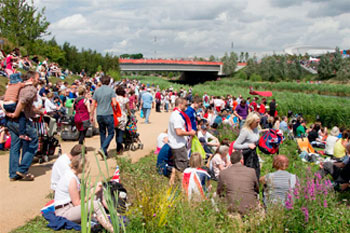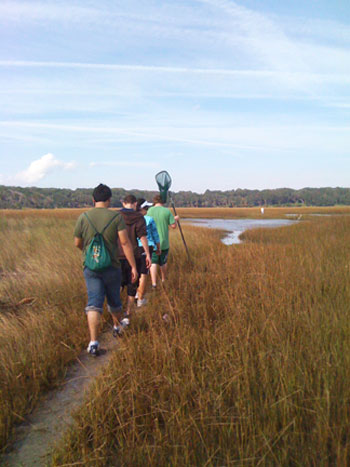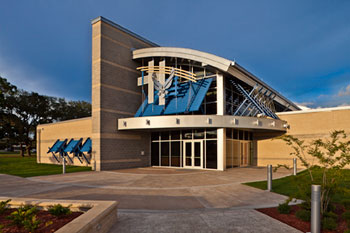Advancing Sustainable Engineering
As the North American CEO of a global design, engineering and project-management consultancy, I am continually impressed with how engineers can create sustainable infrastructure solutions. For example, in Issue 19 (April 2012) of livebetter magazine, engineers Martyn Lass and Kim Oliver told how their team of engineers, project managers, ecologists, soil scientists and sustainability experts collaborated with the United Kingdom’s Olympic Delivery Authority to transform the notoriously polluted Lower Lea Valley in East London into the 2012 Olympic Park. This 25-acre sporting venue is now being transitioned into a lush wetlands and woodlands park that will benefit London citizens for generations.

Photo Courtesy: Atkins | In 2012, London’s Olympic Park visitors enjoyed a river-edge pond that was transformed from a polluted brownfield site.
However, while pleased to see today’s engineering accomplishments, I’m also concerned about how much more needs to be done to preserve and sustain our environment while still enabling human society to grow and expand. More than ever, engineers must take the lead in developing the kind of infrastructure solutions that will take us into a secure, equitable and prosperous future.
Engineers Come First
Which came first, the chicken or the egg? It’s an old question that’s tough to answer, but with regard to sustainability, I firmly believe the engineer comes first. That’s because engineers have the training, education and expertise necessary to be the recommenders, designers and creators of efficient, elegant and affordable sustainability initiatives.
Alexander Graham Bell once said that “before anything else, preparation is the key to success.” This is particularly true for engineers because they must be attuned to sustainability from the beginning of their careers. As a result, the profession has a responsibility to nurture and encourage young students to help focus their attention on how to resolve environmental issues. Atkins supports this mission through its North American 501(c)(3) charitable foundation, the Atkins Foundation, Inc., which has donated more than $2 million to US high schools, universities and charities.

Photo Courtesy: Atkins | Students from the St. Johns County (Fla.) Career Academy collect samples from a salt marsh tidal creek in North Florida.
As an example, one of our recent grants went to the St. Johns County’s Florida Education Foundation in support of Creekside High School’s Academy of Environmental and Urban Planning. The Academy – a specialized “learning community” within the high school – assists students in gaining real-world knowledge and experience that can help them pursue science, technology, engineering and math (STEM) careers. Supported by a volunteer team of Atkins mentors, the grant was used to fund student field trips to Jacksonville University’s Marine Science Research Institute and to support Project GREEN/Project INNOVATE, the Academy’s annual environmental student design competition.
Atkins is also committed to the ongoing education of professional engineers through its “My Development” program. For example, as a corporate member of the US Green Building Council® (USGBC®), we provide comprehensive preparatory education for staff engineers who desire LEED® (Leadership in Energy and Environmental Design™) professional certification. This includes a complete range of courses for those preparing for the LEED Green Associate exam and Accredited Professional exams (including BD+C, ID+C and ND specialty exams).
These types of organizational investments are vital because today’s daunting sustainability challenges require experienced, highly committed engineers with passion and conviction to help clients envision possible solutions. With buildings accounting for 72 percent of America’s electricity use, 39 percent of all greenhouse gas emissions and nearly one-half of all raw material consumption [2010 Buildings Energy Data Book, U.S. Department of Energy, March 2011], engineers need to provide better, more proactive solutions. “Green” buildings, with their deliberate and thoughtful design and construction practices, accomplish this by conserving energy, air and water resources, and by reducing solid waste and minimizing greenhouse gas emissions. They also provide significant economic benefits by reducing energy consumption and operating costs.
And, behind every green building is a team of dedicated, well-trained engineers working in partnership with other sustainably dedicated stakeholders. This not only includes USGBC but also other leading industry associations like the American Society of Heating, Refrigerating and Air Conditioning Engineers (ASHRAE), American Institute of Architects (AIA) and National Environmental Balancing Bureau (NEBB).
Visionary Owners are Essential
Beyond the engineers are the “owners” of the built environment – developers, property owners, facility managers, elected officials and residents who support, fund, manage and enable urban sustainability. Global urbanization reminds us that the challenge of sustainability is ultimately a challenge for these front-row stakeholders who drive the critical decisions in the world’s cities.
In a research partnership with the United Kingdom’s Department for International Development and University College London, Atkins recently published a significant new report on this topic, Future Proofing Cities, (www.futureproofingcities.com). The report is based on an assessment of risks, vulnerabilities and capacities of 129 cities in 20 countries. It indicates that 75 percent of the world’s population will likely live in cities by 2050 — a remarkable societal shift because in 1900 only 10 percent of human beings lived in urban environments.

Photo Courtesy: Atkins | Tyndale Air Force Base’s Fitness Center achieved Platinum-level LEED certification without exceeding the original budget allocation.
Cities occupy only two per cent of the earth’s land surface but account for 60 to 80 percent of the world’s energy consumption and 75 percent of human-related carbon emissions. Like it or not, with the vast majority of the world’s population being urbanized, city builders and managers are being thrust to the forefront of dealing with climate change, lack of resources and ecosystem damage.
What Atkins calls “future proofing” is about creating the kind of cities that can respond in truly sustainable ways to the risks and complexities of the future. The good news for developers and owners is that cost – perhaps the most frequently cited barrier to sustainability initiatives – is rapidly becoming a non-issue as technology, improved processes and mass production work to improve the return-on-investment of sustainable engineering. A recent article in The American Journal of Civil Engineering and Architecture states: “The major economic benefits of sustainable construction are reduced operation and utility costs, reduced maintenance costs and an overall improvement in [building] performance and efficiency¹.”
One way to gain notable bottom-line benefits when constructing a new building is to integrate an effective commissioning process into the plans. Building commissioning is an increasingly popular, structured process for ensuring a facility’s systems and assemblies meet defined performance objectives. And, it makes good economic sense according to the National Institute of Building Sciences, which states that building “owners can achieve savings in operations of $4 over the first five years of occupancy as a direct result of every $1 invested in commissioning².”
Solving Today’s Challenges
Former US Secretary of State John Foster Dulles once said that “the measure of success is not whether you have a tough problem to deal with but whether it is the same problem you had last year.”
In 2012, Atkins’ associate vice president and senior water resources engineer Dan Medina wrote an article for World Water magazine about the importance of viewing stormwater as a resource to embrace rather than an enemy to defeat. In it, he cited landscaped (e.g., “green”) rooftops as an example of today’s increasingly popular low-impact development (LID) model. The green rooftop is an affordable and sustainable strategy that has been in use in Europe for hundreds of years. Now the approach is gaining ground in the United States – specifically in cities like Atlanta, Chicago and Portland, Oregon.
But despite some progress in implementing LID, there’s much more to do. For example, I recently saw an industry trade journal article about the first green rooftop in San Jose, Calif., being installed only a few years ago. Then just days later, I came across another article describing the success of the first green rooftop on a public building in the Pittsburgh, Penn., area – also installed just a few years ago. If possible, every new building should have sustainable roofing integrated into its plans.
It is my personal mission to do whatever I can – and to help Atkins’ North American engineers do whatever they can – to solve today’s tough sustainability challenges so we’re not dealing with the same problems year after year.





























